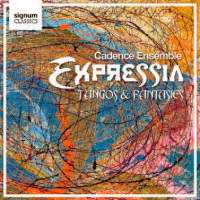
A Curate's Egg
Tangos and fantasies -
explored by
HOWARD SMITH'... good in parts.'
|

|
Cadence's first six tracks are items by Ástor Pantaleón Piazzolla. Three of the remaining works were arranged by Cadence leader Babakhanian, and the piece Tango 'Expressia', from which this CD takes its title, is by Armenian composer Narine Zarifyan (born 1958), a graduate of Yerevan State Conservatory (1984), where she now holds a professorship.
In sum the programme (recorded at Abbey Road) consists of Escualo, Romance Del Diablo, Tango Del Diablo, Poem, Muerte Del Angel and Concerto Para Quinteto (all by Piazzolla); 'Tango' Por Una Cabeza (Gardel), 'Tango' Expressia (Zarifyan), 'Tango' El Ultimo Café (Stamponi) and Fantasy on Themes of 'Porgy And Bess' (Gershwin).
Listen -- Piazzolla: Escualo
(track 1, 2:14-3:13) © 2008 Signum Records Ltd
Cadence get away to an arresting start with Piazzolla's ferocious Escualo (translated as 'Shark') though no one seems able to match the chilling menace soundtrack composer John Williams' pivotal 2-3-note motif brought to Steven Spielberg's Jaws in 1975. Play those two notes for anyone and they will associate it with water and approaching danger.
Sometimes the simplest solution is the best. To this day, Spielberg is convinced his 'breakthrough' film owed much of its success to Williams' music. That instantly recognizable notation is as primitive and raw as the marine predator itself.
Babakhanian and violinist Khoyetsyan really dig into the driving Escualo (Ritmo Libre). For a short time within the central section, Piazzolla's 'shark' appears to become a shade disoriented; nonetheless this item is most effective.
The Latino genre makes frequent reference to devils and angels -- though what one should make of Cadence tackling Piazzolla's Romance del Diablo escapes me. More than anything else, it brought to mind the third line from Lewis Carroll's nonsense verse poem Jabberwocky :
'Twas brillig, and the slithy toves
Did gyre and gimble in the wade;
All mimsy were the borogoves, ...
'Mimsy' would seem to be a combination of 'miserable' and 'flimsy' -- a perfect description of track 2.
Next up, Tango del Diablo brims with sound, fury, and glissandi. This pastiche of upbeat Bartókian propulsion and ersatz European patisserie musique doesn't cut it either.
Listen -- Piazzolla: Tango del Diablo
(track 3, 0:25-1:07) © 2008 Signum Records Ltd
Poem comes over as sadly clichéd after-midnight music when the bars are nearly deserted; the musicians nearly ready to pack up; not quite Brief Encounter style and nowhere near so effective as Arthur 'Dooley' Wilson (1886-1953) as pianist Sam with 'As time goes by', Herman Hupfeld's song in Casablanca (1942).
In Piazzolla's high octane Muerte del Angel (track 5), Cadence spring into renewed life; with the motivic rhythms they seem best at. 'Muerte ...' sets out in strident fugal fashion giving way to a languid, smoky dance (1'15"), only to reappear (2'31") till the final, predictable glissando.
Listen -- Piazzolla: Muerte del Angel
(track 5, 2:45-3:21) © 2008 Signum Records Ltd
The concluding Piazzolla track, Concierto Para Quinteto, is captured with sovereign authority on Tango Zero Hour (Nonesuch, 1986) by the composer (on bandoneón) and fellow musicians Fernando Suárez Paz, violin; Pablo Ziegler, piano; Horacio Malvicino, Sr, guitar; and Héctor Console, bass.
Tango Zero Hour is an invincible 20th century recording beside which Cadence seems very pale beer indeed.
The first change of composer introduces Carlos Gardel (1887/1890 -- 1935, Colombia) a prominent figure in the history of tango. His birthplace remains uncertain, however he lived in Argentina from childhood -- becoming an Argentine citizen (1923), commonly referred to as 'Carlitos', 'The King of Tango', 'El Mago' (The Magician) and, ironically 'El Mudo' (The Mute).
His Tango Por Una Cabeza meaning 'by a head (of a horse)' is a popular tango song composed in 1935 by Carlos Gardel and Alfredo Le Pera. Gardel was the composer and Le Pera the lyricist.
The original lyrics speak of a compulsive horse-track gambler who compares his addiction for the horses with his attraction to women.
Listen -- Gardel: Tango Por Una Cabeza
(track 7, 3:46-4:35) © 2008 Signum Records Ltd
Pianist-arranger Babakhanian has reworked Gardel's piece largely as a violin and piano duo; allowing himself an exotic, somewhat flowery accompanying role.
Tango Expressia is from an original by Armenian composer Zarifyan (see above). Her bracingly innovative item requires a unanimity of imput from the entire quintet. I found myself sitting on the edge of my seat for its entire 3 minutes, 38 seconds.
Another unfamiliar name for me was pianist, composer and arranger Hector ('Shot') Stamponi (born at Campana, Buenos Aires province in 1916 and died 1997, Buenos Aires). His Tango El Ultimo Café begins with a Liberace-style Babakhanian introduction and proceeds on its saccharine way with populist ingredients which may well find many friends.
As for the concluding Fantasy on Themes from Porgy and Bess, the least said the soonest mended. Too many others do this sort of thing incomparably. It just ain't Cadence territory.
In sum 'Expressia' is something of a curate's egg -- good in parts.
Copyright © 10 December 2008
Howard Smith, Masterton, New Zealand
 BUY CLASSICAL CDS ONLINE
CD INFORMATION: EXPRESSIA - TANGOS AND FANTASIES
BUY CLASSICAL CDS ONLINE
CD INFORMATION: EXPRESSIA - TANGOS AND FANTASIES
| 
